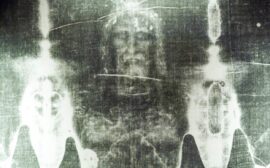We originally planned to have 4 parts to this topic. However, as time has progressed, it has become necessary to have five parts. So if previous articles listed only four in this series…understand that yes, I can count and have not lost my mind. 🙂 The material required five articles instead of four. God bless.
Evidence for the Resurrection of Jesus Christ
Part 4: Psychological Evidence
by: Pastor Brian Chilton
When my cousin and I were younger, we would stay at our grandparents’ house after getting home from school until our parents came to pick us up. My cousin was older than I. He would go home by himself because he was old enough to do so. My cousin has always had the knack for telling good stories. Some of the stories were true and some were not. One time, he got off the bus and had claimed that he had broken his arm. He had it bandaged up and everything. We were all concerned and asked him how he broke his arm. He told us and then went home. I told my dad about him breaking his arm. So later that afternoon, my dad called my uncle and asked about my cousin. My uncle said, “He did not break his arm. He is just fine.” We were all astonished because he had pulled a very clever prank. The prank did not last long because the truth eventually came out.
When it comes to lies, or conspiracies, eventually there is a break and the truth wins in the end. Many are engrossed with conspiracy theories in our day and time. Some are infatuated with the fictional conspiracy tales of Dan Brown. On late night radio shows and even on some major channels, conspiracies are discussed. Some have postulated that Christianity itself is a big conspiracy. However, when the evidence is examined, one finds that conspiracy theories just do not hold water when speaking about the historicity of Christ’s resurrection. So in this article, we wish to examine the psychological evidence found in that people do not die for lies and we will examine the psychological nature of conspiracies as given by J. Warner Wallace in his book Cold-Case Christianity.
Would You Die for a Lie
A story is told of a group of people going into a congregation of 5,000 people and threatening to assault the Christians in attendance. Everyone except 50 left. The pretend assaulters proclaimed, “Now we know who the real Christians are.” It is one thing to die for something someone believes in, but it is something completely different to die for something you know to be true or false. This is the case with the early Christians. They died for what they knew to be true. John writes, “What we have seen and heard we proclaim to you also, so that you too may have fellowship with us; and indeed our fellowship is with the Father, and with His Son Jesus Christ.”[1] John reported what he had “seen” and “heard.” Going back to our original story about my cousin, we can see that when probed my cousin finally relented and told the truth. For one, there was no evidence that my cousin’s arm was broken. Secondly, when threatened with possible punishment, he quickly told the truth.
However, the same is not the case with the early Christians. They never relented even when posed with severe punishment. Consider the fact that the following individuals died for their faith:
-Simon Peter (crucified upside-down in Rome),
-Andrew (crucified on an “X” shaped cross in southern Greece),
-James, son of Zebedee (killed with the sword),
-John, son of Zebedee (exiled to the Isle of Patmos),
-Matthew (killed by sword in Ethiopia),
-Thomas (killed by stabbing in Madras, India),
-Philip (crucified in Phyrgia),
-Simon the Canaanite (hacked to death in Egypt),
-Bartholomew, otherwise known as Nathaniel (skinned alive and then beheaded in Armenia),
-Thaddeus (killed in Persia)
-James the Less (executed in Egypt),
-James, the brother of Jesus (thrown off the Temple mount and beaten to death with clubs),
-Paul (beheaded at about the same time Peter was crucified in Rome in 67 AD).
Other Christians were fed to lions, burned at the stake, and killed viciously. Yet, none of them forsook the story that they had in fact seen Jesus raised from the dead. This speaks volumes as to the historicity of the claim. If Jesus’ body were in the tomb, all that would have happened would be that the enemies would have exposed the body and then the story would have been over. Yet a body was never retrieved and the apostles never recanted. But, another piece of psychological information exists…that of the non-relational attributes of conspiracy theories.
Resurrection Witness Does Not Match Conspiracies
J. Warner Wallace, a cold-case detective and former atheist (now a Christian), gives five prerequisites that must exist in order for a conspiracy to remain intact in the seventh chapter of his book Cold-Case Christianity. Wallace writes, “In my experience as a detective, I have investigated many conspiracies and multiple-suspect crimes. While successful conspiracies are the popular subject of many movies and novels, I’ve come to learn that they are (in reality) very difficult to pull off. Successful conspiracies share a number of common characteristics: A SMALL NUMBER OF CONSIRATORS…THOROUGH AND IMMEDIATE COMMUNICATION…A SHORT TIME SPAN…SIGNIFICANT RELATIONAL CONNECTIONS…LITTLE OR NO PRESSURE.”[2]
Let’s consider Wallace’s five points. First, Wallace noted that a conspiracy had to contain a “small number of conspirators.” Remember from our previous post (See Eyewitness Testimony article) that there were over 500 witnesses who saw Jesus alive from the dead. It could have been as high as 3,000 witnesses that day. Numerous people were saying the same thing. If the resurrection was based on a lie, someone somewhere would have cracked and told the conspiracy. It only took my uncle to crack the case of my cousin’s broken arm…one conspirator! How does a conspiracy pass the test with hundreds if not thousands proclaiming the same thing?
Second, Wallace mentions that a conspiracy must have “thorough and immediate communication.” Everyone needed to be in direct communication with one another at all times. Yet in the gospel accounts, we do not see an organized arrangement of resurrection accounts. They are what one would expect to find if they were reporting actual eyewitness testimony…somewhat scattered coming from different eyewitnesses. In Jesus’ day, no mass media outlets were available. It would have been much easier for the authorities to crack the resurrection case if in fact the resurrection was false. That never happened.
Third, Wallace lists that conspiracies must have “a short time span.” Yet, the message of the resurrection has lasted even until now with direct succession of testimony from the earliest apostles.[3] In other words, the longer a lie is given the more likelihood that the lie will break. This never happened in close to 2,000 years since the resurrection of Christ transpired.
Fourth, Wallace lists that conspiracies must have “significant relational connections.” In other words, for a conspiracy to work there must be close family ties. A person will be more likely to “rat out” a person that is not family rather than one who is. With the disciples of Jesus, you do have some who are loosely related to Jesus (John and James could have been Jesus’ cousins) and some who are directly related to Jesus (Mary, the mother of Jesus and James the brother of Jesus). But remember, the brothers of Jesus did not believe in Jesus during His earthly ministry and only came to follow Him after the resurrection. For the most part, the disciples were unrelated to Jesus. Perhaps this was why many left Jesus when He was being tried. However, they all came back and professed Jesus as the risen Lord…some who had been adversaries of Jesus (James, Jude, Paul, and even some of the Sanhedrin who condemned Jesus).[4] This does not fit the mold of a conspiracy.
Finally, Wallace lists that a conspiracy must have “little or no pressure.” The higher the temperature results in the higher chance that something will melt. With respects to musician Glenn Frey, “the heat was on” for the apostles. From the beginning, the Christians were excommunicated and cast-aways from the society in general. During the time of Nero when many eyewitnesses were still living, massive waves of Christian persecution swept across the Roman Empire but the message only grew stronger! This is exactly the opposite of what one would expect from a conspiracy!
Hence, psychologically we find that Christianity is built upon a historical event that transformed the lives of the Christians: the resurrection of Jesus Christ. The resurrection was not a hallucination. It was not a cleverly devised plan. It was a historical fact. You too can be transformed by the amazing power of the resurrection. Will you allow the Risen Jesus to have access to your life today by entering into a relationship with Him? The resurrection still brings power to those who are willing to embrace this historical fact even after 2,000 years.
Bibliography
All Scripture unless otherwise noted comes from New American Standard Bible: 1995 Update (LaHabra, CA: The Lockman Foundation, 1995).
Wallace, J. Warner, Cold-Case Christianity (Colorado Springs, CO: David C. Cook Publishers, 2013).
[1] New American Standard Bible: 1995 Update (LaHabra, CA: The Lockman Foundation, 1995), 1 Jn 1:3.
[2] J. Warner Wallace, Cold-Case Christianity (Colorado Springs, CO: David C. Cook Publishers, 2013), 110-112.
[3] See chapter 13 “Were They Accurate?” of J. Warner Wallace’s book Cold-Case Christianity for a thorough review of apostolic succession. Multiple lines of apostolic authority existed.
[4] Specifically Nicodemus and Joseph of Arimathea were part of the Sanhedrin that condemned Jesus. However, it is not clear if Nicodemus and Joseph were in the party that condemned Jesus. It may have been that they were absent at the trial.





Brilliant. I agree.
WOW just what I was looking for. Came here by searching for the
Hey Wendi, thanks for the suggestion. I have made a note and will try to add more visuals as we progress. Thanks and God bless.
I was curious if you ever thought of changing the page layout of your website?
Its very well written; I love what youve got to say. But maybe you could a little more in the way of content so people could connect
with it better. Youve got an awful lot of text for only having one or 2 images.
Maybe you could space it out better?